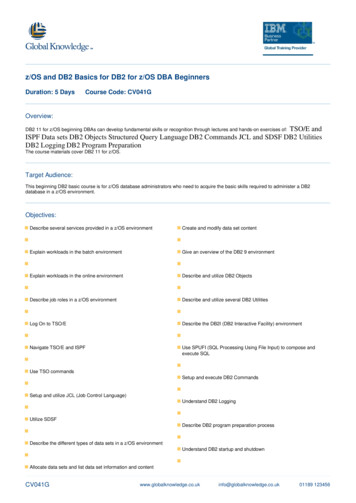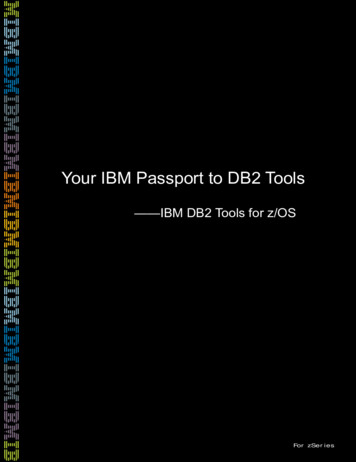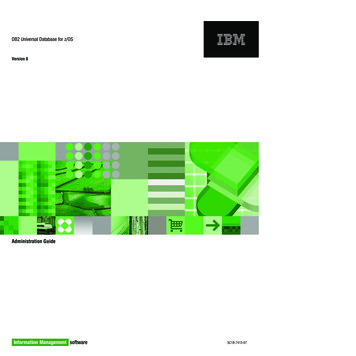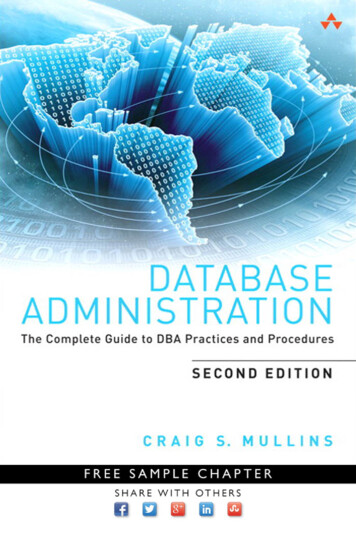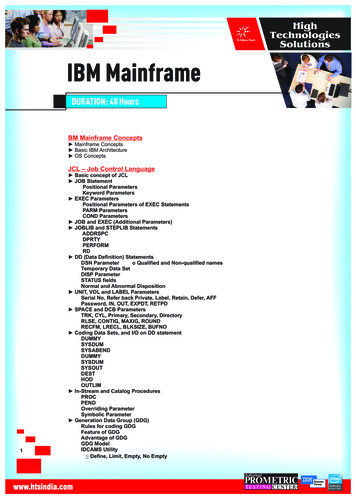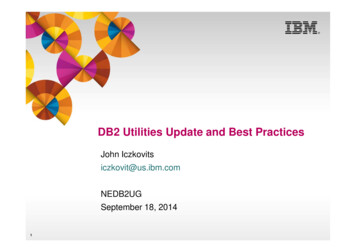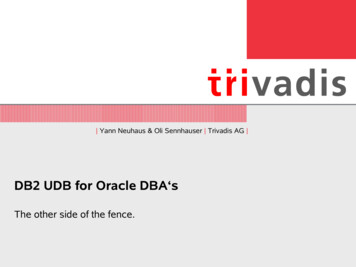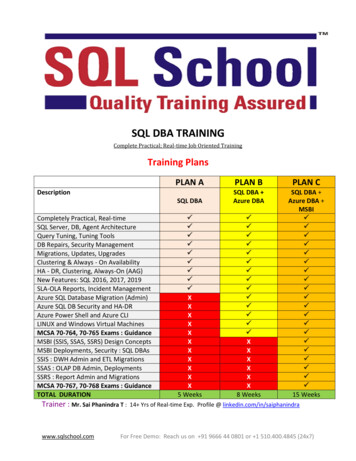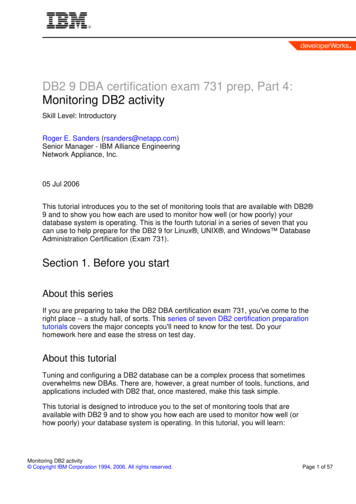
Transcription
DB2 9 DBA certification exam 731 prep, Part 4:Monitoring DB2 activitySkill Level: IntroductoryRoger E. Sanders (rsanders@netapp.com)Senior Manager - IBM Alliance EngineeringNetwork Appliance, Inc.05 Jul 2006This tutorial introduces you to the set of monitoring tools that are available with DB2 9 and to show you how each are used to monitor how well (or how poorly) yourdatabase system is operating. This is the fourth tutorial in a series of seven that youcan use to help prepare for the DB2 9 for Linux , UNIX , and Windows DatabaseAdministration Certification (Exam 731).Section 1. Before you startAbout this seriesIf you are preparing to take the DB2 DBA certification exam 731, you've come to theright place -- a study hall, of sorts. This series of seven DB2 certification preparationtutorials covers the major concepts you'll need to know for the test. Do yourhomework here and ease the stress on test day.About this tutorialTuning and configuring a DB2 database can be a complex process that sometimesoverwhelms new DBAs. There are, however, a great number of tools, functions, andapplications included with DB2 that, once mastered, make this task simple.This tutorial is designed to introduce you to the set of monitoring tools that areavailable with DB2 9 and to show you how each are used to monitor how well (orhow poorly) your database system is operating. In this tutorial, you will learn:Monitoring DB2 activity Copyright IBM Corporation 1994, 2006. All rights reserved.Page 1 of 57
developerWorks ibm.com/developerWorks How the database system monitor works How snapshot information is collected How event monitors are created and how event monitor data is collected How the health monitor and the Health Center are used How comprehensive explain data and explain snapshot data differ How comprehensive explain data and explain snapshot data is collected How Visual Explain is used to view explain snapshot dataThis is the fourth tutorial in a series of seven tutorials to help you prepare for theDB2 9 for Linux, UNIX, and Windows Database Administration Certification (Exam731). The material in this tutorial primarily covers the objectives in Section 4 of theexam, entitled "Analyzing DB2 Activity." You can view these objectives l.ObjectivesAfter completing this tutorial, you should be able to: Capture snapshots using GET SNAPSHOT or SQL functions Create and activate event monitors Configure the health monitor using the Health Center Capture and analyze explain/Visual Explain information Identify the functions of DB2's problem determination tools (for example,db2pd and db2mtrk)PrerequisitesTo take the DB2 9 DBA exam, you must have already passed the DB2 9Fundamentals exam 730. We recommend that you take the DB2 Fundamentalstutorial series before starting this series.To help you understand some of the material presented in this tutorial, you shouldbe familiar with the following terms: Structured Query Language (SQL): A standardized language used todefine objects and manipulate data in a relational database. DB2 optimizer: A component of the SQL precompiler that chooses anaccess plan for a Data Manipulation Language (DML) SQL statement bymodeling the execution cost of several alternative access plans andchoosing the one with the minimal estimated cost.Monitoring DB2 activityPage 2 of 57 Copyright IBM Corporation 1994, 2006. All rights reserved.
ibm.com/developerWorksdeveloperWorks System requirementsYou do not need a copy of DB2 to complete this tutorial. However, you will get moreout of the tutorial if you download the free trial version of IBM DB2 9 to work alongwith this tutorial.Section 2. Capturing snapshot dataThe database system monitorDatabase monitoring is a vital activity that, when performed on a regular basis,provides continuous feedback on the health of a database system. Becausedatabase monitoring is such an integral part of database administration, DB2 9comes equipped with a monitoring utility known as the database system monitor.Although the name "database system monitor" suggests that only one monitoringtool is provided, in reality the database system monitor is composed of two distincttools that can be used to capture and return system monitor information: a snapshotmonitor and one or more event monitors. The snapshot monitor allows you tocapture a picture of the state of a database at a specific point in time while eventmonitors capture and log data as specific database events occur. Informationcollected by both tools is stored in entities that are referred to as monitor elements(or data elements). Each monitor element used is identified by a unique name and isdesigned to hold a specific type of information. The following types of elements areused to store monitor data: Counters. Counters keep a total count of the number of times an activityor event has occurred. Counter values increase throughout the life of themonitor; often a counter monitor element is resettable. An example of acounter element would be the total number of SQL statements that havebeen executed against a database. Gauges. Gauges keep a count of the number times an activity or eventhas occurred at a specific point in time. Unlike counter values, gaugevalues can go up or down, and their value at any given point in time isusually dependent upon the level of database activity. An example of agauge element would be the number of applications that are currentlyconnected to a database. Watermarks. Watermarks indicate the highest (maximum) or lowest(minimum) value an item has seen since monitoring began. An exampleof a watermark element would be the largest number of rows that wereMonitoring DB2 activity Copyright IBM Corporation 1994, 2006. All rights reserved.Page 3 of 57
developerWorks ibm.com/developerWorksaffected by an update operation. Information. As the name implies, information elements providereference-type details of all monitoring activities performed. Examples ofinformation elements would include buffer pool names, database namesand aliases, path details, etc. Timestamps. Timestamps indicates the date and time an activity or eventtook place. Timestamp values are provided as the number of secondsand microseconds that have elapsed since January 1, 1970. An exampleof a timestamp element would be the date and time the first connection toa database was established. Time. Time elements keep track of the amount of time that was spentperforming an activity or event. Time values are provided as the numberof seconds and microseconds that have elapsed since the activity orevent was started and some time elements are resettable. An example ofa time element would be the amount of time that was spent performing asort operation.The database system monitor can utilize any combination of these elements tocapture monitor data, and once collected, several methods can be used to presentthe data stored in each element used; for both snapshot monitors and eventmonitors, you have the option of storing all data collected in files or database tables,viewing it on-screen, or processing it using a custom application. (The databasesystem monitor returns monitor data to a client application using a self-describingdata stream. With a snapshot monitoring application you call the appropriatesnapshot APIs to capture a snapshot and then process the data stream returned;with an event monitoring application, you prepare to receive the data produced via afile or a named pipe, activate the appropriate event monitor, and process the datastream as it is received.)The snapshot monitorThe snapshot monitor is designed to collect information about the state of a DB2UDB instance and the databases it controls at a specific point in time (in otherwords, at the time the snapshot is taken). Snapshots are useful for determining thestatus of a database system, and when taken at regular intervals, they can providevaluable information that can be used to observe trends and identify potentialproblem areas. Snapshots can be taken by executing the GET SNAPSHOT commandfrom the DB2 Command Line Processor (CLP), by using the appropriate snapshottable functions in a query, or by using the snapshot monitor APIs in a C or C application. Additionally, snapshots can be tailored to return specific types ofmonitoring data values (for example, a snapshot could be configured to return justinformation about buffer pools).Monitoring DB2 activityPage 4 of 57 Copyright IBM Corporation 1994, 2006. All rights reserved.
ibm.com/developerWorksdeveloperWorks Snapshot monitor switchesOften, the collection of system monitor data requires additional processingoverhead. For example, in order to calculate the execution time of SQL statements,the DB2 Database Manager must make a call to the operating system to obtaintimestamps before and after any SQL statement is executed. These types of systemcalls can be expensive. Another side effect of using the system monitor is that theamount of memory consumed is increased - the DB2 Database Manager usesmemory to store the data collected for every monitor element being tracked by thesystem monitor.To help minimize the overhead involved in collecting system monitor information, agroup of switches known as the snapshot monitor switches can be used to controlwhat information is collected when a snapshot is taken; the type and amount ofinformation collected is determined by the way these snapshot monitor switcheshave been set. Each snapshot monitor switch has two settings: ON and OFF. Whena snapshot monitor switch is set to OFF, monitor information is not collected forelements that fall under that switch's control. The opposite is true if the switch is setto ON. (Keep in mind that a considerable amount of monitoring information is notunder switch control and will always be collected regardless of how the snapshotmonitor switches have been set.) The snapshot monitor switches available, alongwith a description of the type of information that is collected when each is set to ON,can be seen in Table 1.Table 1. Snapshot monitor switchesMonitor GroupMonitor SwitchDBM ConfigurationParameterInformation ProvidedBuffer PoolsBUFFERPOOLdft mon bufferpoolAmount of buffer poolactivity (in other words,number of read andwrite operationsperformed and theamount of time takenfor each read/writeoperation).LocksLOCKdft mon lockNumber of locks heldand number ofdeadlock cyclesencountered.SortsSORTdft mon sortNumber of sortoperations performed,number of heaps used,number of overflowsencountered, and sortperformance.SQL StatementsSTATEMENTdft mon stmtSQL statementprocessing start time,SQL statementprocessing end time,and SQL statementidentification.Monitoring DB2 activity Copyright IBM Corporation 1994, 2006. All rights reserved.Page 5 of 57
developerWorks ibm.com/developerWorksTablesTABLEdft mon tableAmount of table activityperformed such asnumber of rows read,number of rows written,etc.TimestampsTIMESTAMPdft mon timestampTimes and timestampinformation.TransactionsUOWdft mon uowTransaction start times,transaction completiontimes, and transactioncompletion status.By default, all of the switches shown in Table 1 are set to OFF, with the exception ofthe TIMESTAMP switch, which is set to ON and initialized when an instance is firststarted.Viewing current snapshot monitor switch settingsIt was mentioned earlier that the type and amount of information collected when asnapshot is taken is controlled, to some extent, by the way the snapshot monitorswitches have been set. Before you take a snapshot, it is important that you knowwhich snapshot monitor switches have been turned on and which snapshot monitorswitches remain off. How can you find out what the current setting of each snapshotmonitor switch available is? The easiest way is by executing the GET MONITORSWITCHES command from the DB2 Command Line Processor (CLP). The basicsyntax for this command is:GET MONITOR SWITCHES AT DBPARTITIONNUM [PartitionNum] where PartitonNum identifies the database partition (in a multi-partitioned databaseenvironment) for which the status of the snapshot monitor switches available is to beobtained and displayed.Note : Parameters shown in angle brackets ( ) are optional; parameters or optionsshown in normal brackets ([ ]) are required; and a comma, followed by ellipses (.)indicate that the preceding parameter can be repeated multiple times.If you wanted to obtain and display the status of the snapshot monitor switches for asingle-partition database, you could do so by executing a GET MONITOR SWITCHEScommand that looks something like this:GET MONITOR SWITCHESWhen this command is executed from the Command Line Processor, you shouldsee something like the output shown below.Output from GET MONITOR SWITCHES commandMonitoring DB2 activityPage 6 of 57 Copyright IBM Corporation 1994, 2006. All rights reserved.
ibm.com/developerWorksMonitor Recording SwitchesSwitch list for db partition number 0Buffer Pool Activity Information (BUFFERPOOL) OFFLock Information(LOCK) OFFSorting Information(SORT) OFFSQL Statement Information(STATEMENT) OFFTable Activity Information(TABLE) OFFTake Timestamp Information(TIMESTAMP) ONUnit of Work Information(UOW) OFFdeveloperWorks 06-12-2006 10:30:00.028810Upon close examination of this output, notice that the TIMESTAMP snapshotmonitoring switch has been turned on and that all other switches are off. Thetimestamp value that follows the TIMESTAMP monitoring switch's state tells you theexact date and time the TIMESTAMP monitoring switch was turned on (which in thiscase is June 12, 2006, at 10:30 AM).Changing the state of a snapshot monitor switchOnce you know which snapshot monitor switches have been turned ON and whichsnapshot monitor switches have been turned OFF, you may find it necessary tochange one or more switch settings before you begin the monitoring process.Snapshot monitor switch settings can be changed at the instance level by modifyingthe appropriate DB2 Database Manager configuration parameters (see Table 1) withthe UPDATE DATABASE MANAGER CONFIGURATION command.On the other hand, snapshot monitor switch settings can be changed at theapplication level by executing the UPDATE MONITOR SWITCHES command. Thebasic syntax for this command is:UPDATE MONITOR SWITCHES USING [[SwitchID] ON OFF ,.]where SwitchID identifies one or more snapshot monitor switches whose state is tobe changed. This parameter may contain any or all of the following values:BUFFERPOOL, LOCK, SORT, STATEMENT, TABLE, TIMESTAMP, and UOW.If you wanted to change the state of the LOCK snapshot monitor switch to ON at theapplication level), you could do so by executing an UPDATE MONITOR SWITCHEScommand that looks like this:UPDATE MONITOR SWITCHES USING LOCKS ONLikewise, if you wanted to change the state of the BUFFERPOOL snapshot monitorswitch to OFF, you could do so by executing a UPDATE MONITOR SWITCHEScommand that looks like this:UPDATE MONITOR SWITCHES USING BUFFERPOOL OFFSetting snapshot monitor switches at the instance level (using the UPDATEDATABASE MANAGER CONFIGURATION command) affects all databases under theinstance's control (in other words, every application that establishes a connection toa database under the instance's control will inherit the switch settings made in theMonitoring DB2 activity Copyright IBM Corporation 1994, 2006. All rights reserved.Page 7 of 57
developerWorks ibm.com/developerWorksinstance's configuration). Additionally, snapshot monitor switch settings made at theinstance level remain persistent across instance restarts.Setting monitor switches at the application level (using the UPDATE MONITORSWITCHES command) only affects the database a single application is interactingwith. In addition, switch setting made are only persistent for the life of theapplication.Capturing snapshot monitor dataAs soon as a database is activated or a connection to a database is established, thesnapshot monitor begins collecting monitor data. However, before any data collectedcan be viewed, a snapshot must be taken. (A snapshot is essentially a picture ofwhat the monitor elements being used look like at a specific point in time.)Snapshots can be taken by embedding the db2GetSnapshot() API in anapplication program, or by executing the GET SNAPSHOT command. The basicsyntax for this command is:GET SNAPSHOT FOR[DATABASE MANAGER DB MANAGER DBM] ALL DATABASES ALL APPLICATIONS ALL BUFFERPOOLS ALL REMOTE DATABASES ALL REMOTE APPLICATIONS ALL ON [DatabaseAlias] DATABASE ON [DatabaseAlias] APPLICATIONS ON [DatabaseAlias] TABLES ON [DatabaseAlias] TABLESPACES ON [DatabaseAlias] LOCKS ON [DatabaseAlias] BUFFERPOOLS ON [DatabaseAlias] DYNAMIC SQL ON [DatabaseAlias]where DatabaseAlias identifies the alias assigned to the database that snapshotmonitor information is to be collected for.If you want to take a snapshot that only contains data collected on locks being heldby applications interacting with a database named PAYROLL, you could do so byexecuting the following command:GET SNAPSHOT FOR LOCKS ON PAYROLLThe output produced by this command would look something like that shown inbelow. (Keep in mind that this is a simple example. A real monitoring situationusually generates a large amount of data.)Sample output from GET SNAPSHOT commandDatabase Lock SnapshotMonitoring DB2 activityPage 8 of 57 Copyright IBM Corporation 1994, 2006. All rights reserved.
ibm.com/developerWorksdeveloperWorks Database nameDatabase pathInput database aliasLocks heldApplications currently connectedAgents currently waiting on locksSnapshot timestamp 04 08:39:40.750316Application handleApplication IDSequence numberApplication nameCONNECT Authorization IDApplication statusStatus change timeApplication code pageLocks heldTotal wait time (ms) 8*LOCAL.DB2.00E2861339310001db2bp.exeDB2ADMINUOW WaitingNot Collected12522Not CollectedList Of LocksLock NameLock AttributesRelease FlagsLock CountHold CountLock Object NameObject TypeMode 0Internal P LockSLock NameLock AttributesRelease FlagsLock CountHold CountLock Object NameObject TypeMode 0Internal P LockSAs you can see, the GET SNAPSHOT command can be used to capture severaldifferent types of monitoring data, including: DB2 Database Manager instance data Database data for all active databases under an instance's control Application data Buffer pool activity data Tablespace data Table data Lock data (information about all locks held) Dynamic SQL data (point-in-time information about SQL statements beingheld in the SQL statement cache)You may also have noticed that there is a direct correlation between the snapshotmonitor switches available and the different types of monitoring data that can becollected when a snapshot is taken. If a particular snapshot monitor switch is turnedoff and a snapshot of the monitoring elements associated with that switch is taken,the monitoring data captured may not contain any values at all. (In the previousexample, some values were listed as Not Collected because the correspondingMonitoring DB2 activity Copyright IBM Corporation 1994, 2006. All rights reserved.Page 9 of 57
developerWorks ibm.com/developerWorkssnapshot monitor switch was turned off. Furthermore, if no locks had been acquiredat the time the snapshot was taken, the value for Locks held would have been 0 andthe List of Locks information shown would not have been produced.)Capturing snapshot monitor data using SQLWith earlier versions of DB2 UDB, the only way to capture snapshot monitor datawas by executing the GET SNAPSHOT command or by calling its corresponding APIfrom an application program. With DB2 UDB version 8.1, the ability to capturesnapshot monitor data by constructing a query was introduced. This method reliedon twenty special snapshot monitor table functions that have been depreciated inversion 9.1. Now, snapshot monitor data can be obtained by using a new set of SQLroutines to access data stored in special administrative views. These routines andviews are described in Table 2.Table 2. Snapshot administrative SQL routines and viewsAdministrative ViewRoutineDescriptionAPPLICATIONSN/AThis administrative viewcontains information aboutconnected databaseapplications.APPL PERFORMANCEN/AThis administrative viewcontains information about therate of rows selected versusrows read per application.BP HITRATION/AThis administrative viewcontains bufferpool hit ratios,including total, data, and index.BP READ ION/AThis administrative viewcontains bufferpool readperformance information.BP WRITE ION/AThis administrative viewcontains bufferpool writeperformance information.CONTAINER UTILIZATIONN/AThis administrative viewcontains information about tablespace containers and utilizationrates.LOCKS HELDN/AThis administrative viewcontains information on currentlocks held.LOCKWAITSN/AThis administrative viewcontains information on locksthat are waiting to be granted.LOG UTILIZATIONN/AThis administrative viewcontains information about logutilization for the currentlyconnected database.LONG RUNNING SQLN/AThis administrative viewMonitoring DB2 activityPage 10 of 57 Copyright IBM Corporation 1994, 2006. All rights reserved.
ibm.com/developerWorksdeveloperWorks contains information about thelongest running SQL statementsin the currently connecteddatabase.QUERY PREP COSTN/AThis administrative viewcontains a list of SQLstatements, along withinformation about the timerequired to prepare eachstatement.N/ASNAP WRITE FILEThis procedure writes systemsnapshot data to a file in thetmp subdirectory of the instancedirectory.SNAPAGENTSNAP GET AGENTThe administrative view andtable function returnsinformation about agents froman application snapshot, inparticular, the agent logical datagroup.SNAPAGENT MEMORY POOL SNAP GET AGENT MEMORY POOLThis administrative view andtable function returnsinformation about memoryusage at the agent level.SNAPAPPLSNAP GET APPLThe administrative view andtable function returnsinformation about applicationsfrom an application snapshot, inparticular, the appl logical datagroup.SNAPAPPL INFOSNAP GET APPL INFOThe administrative view andtable function returnsinformation about applicationsfrom an application snapshot, inparticular, the appl info logicaldata group.SNAPBPSNAP GET BPThe administrative view andtable function returnsinformation about buffer poolsfrom a bufferpool snapshot, inparticular, the bufferpool logicaldata group.SNAPBP PARTSNAP GET BP PARTThe administrative view andtable function returnsinformation about buffer poolsfrom a bufferpool snapshot, inparticular, thebufferpool nodeinfo logical datagroup.SNAPCONTAINERSNAP GET CONTAINER V91 The administrative view andtable function returns tablespace snapshot informationfrom the tablespace containerlogical data group.Monitoring DB2 activity Copyright IBM Corporation 1994, 2006. All rights reserved.Page 11 of 57
developerWorks ibm.com/developerWorksSNAPDBSNAP GET DB V91SNAPDB MEMORY POOLSNAP GET DB MEMORY POOLThe administrative view andtable function returnsinformation about memoryusage at the database level forUNIX(R) platforms only.SNAPDBMSNAP GET DMBSNAPDBM MEMORY POOLSNAP GET DBM MEMORY POOLThe administrative view andtable function returnsinformation about memoryusage at the database managerlevel.SNAPDETAILLOGSNAP GET DETAILLOG V91The administrative view andtable function returns snapshotinformation from the detail loglogical data group.SNAPDYN SQLSNAP GET DYN SQL V91The administrative view andtable function returns snapshotinformation from the dynsqllogical data group.SNAPFCMSNAP GET FCMThe administrative view andtable function returnsinformation about the fastcommunication manager (FCM)from a database managersnapshot, in particular, the fcmlogical data group.SNAPFCM PARTSNAP GET FCM PARTThe administrative view andtable function returnsinformation about the fastcommunication manager (FCM)from a database managersnapshot, in particular, thefcm node logical data group.SNAPHADRSNAP GET HADRThe administrative view andtable function returnsinformation about highavailability disaster recoveryfrom a database snapshot, inparticular, the hadr logical datagroup.SNAPLOCKSNAP GET LOCKThe administrative view andtable function returns snapshotinformation about locks, inparticular, the lock logical dataMonitoring DB2 activityPage 12 of 57The administrative view andtable function returns snapshotinformation from the database(dbase) and database storage(db storage group) logicalgroupings.The administrative view andtable function returns thesnapshot monitor DB2 databasemanager (dbm) logical groupinginformation. Copyright IBM Corporation 1994, 2006. All rights reserved.
ibm.com/developerWorksdeveloperWorks group.SNAPLOCKWAITSNAP GET LOCKWAITThe administrative view andtable function returns snapshotinformation about lock waits, inparticular, the lockwait logicaldata group.SNAPSTMTSNAP GET STMTThe administrative view andtable function returnsinformation about statementsfrom an application snapshot.SNAPSTORAGE PATHSSNAP GET STORAGE PATHS The administrative view andtable function returns a list ofautomatic storage paths for thedatabase including file systeminformation for each storagepath, specifically, from thedb storage group logical datagroupSNAPSUBSECTIONSNAP GET SUBSECTIONThe administrative view andtable function returnsinformation about applicationsubsections, namely thesubsection logical monitorgrouping.SNAPSWITCHESSNAP GET SWITCHESThe administrative view andtable function returnsinformation about the databasesnapshot switch state.SNAPTABSNAP GET TAB V91The administrative view andtable function returns snapshotinformation from the tablelogical data group.SNAPTAB REORGSNAP GET TAB REORGThe administrative view andtable function return tablereorganization information.SNAPTBSPSNAP GET TBSP V91The administrative view andtable function returns snapshotinformation from the tablespacelogical data group.SNAPTBSP PARTSNAP GET TBSP PART V91 The administrative view andtable function returns snapshotinformation from thetablespace nodeinfo logicaldata group.SNAPTBSP QUIESCERSNAP GET TBSP QUIESCER The administrative view andtable function returnsinformation about quiescersfrom a table space snapshot.SNAPTBSP RANGESNAP GET TBSP RANGEMonitoring DB2 activity Copyright IBM Corporation 1994, 2006. All rights reserved.The administrative view andtable function returnsinformation from a rangesnapshot.Page 13 of 57
developerWorks ibm.com/developerWorksSNAPUTILSNAP GET UTILThe administrative view andtable function returns snapshotinformation on utilities from theutility info logical data group.SNAPUTIL PROGRESSSNAP GET UTIL PROGRESS The administrative view andtable function returnsinformation about utilityprogress, in particular, theprogress logical data group.TBSP UTILIZATIONN/AThis administrative viewcontains table spaceconfiguration and utilizationinformation.TOP DYNAMIC SQLN/AThis administrative viewcontains the top dynamic SQLstatements sortable by numberof executions, averageexecution time, number of sorts,or sorts per statement.If you wanted to obtain lock information for the currently connected database forexample, you could do so by executing a query that looks something like this:SELECT AGENT ID, LOCK OBJECT TYPE, LOCK MODE, LOCK STATUSFROM SYSIBMADM.SNAPLOCKThe SNAP GET LOCK table function returns the same information as the SNAPLOCKadministrative view, but allows you to retrieve the information for a specific databaseor a specific database on a specific database partition (instead of the currentconnected database). A query using the SNAP GET LOCK table function would looksomething like this:SELECT AGENT ID, LOCK OBJECT TYPE, LOCK MODE, LOCK STATUSFROM TABLE(SNAP GET LOCK('',-1)) AS TWhen used with the SNAP GET LOCKWAIT table function, the SNAP GET LOCKtable function provides information equivalent to the GET SNAPSHOT FOR LOCKSON [DatabaseAlias] command.Resetting snapshot monitor countersEarlier, you saw that one of the element types that monitor elements use to storedata is a counter and that counters keep a running total of the number of times anactivity or event occurs. Counter values increase throughout the life of the monitor.So when exactly does counting begin? Counting typically begins as soon as asnapshot monitor switch is turned on or when connection to a database isestablished (if instance level monitoring is used, counting begins the first time anapplication establishes a connection to a database under the instance's control).Monitoring DB2 activityPage 14 of 57 Copyright IBM Corporation 1994, 2006. All rights reserved.
ibm.com/developerWorksdeveloperWorks However, there may be times when it is desirable to reset all counters to zerowithout turning snapshot monitor switches off and back on and without terminatingand reestablishing database connections. By far the easiest way to quickly reset allsnapshot monitor counters to zero is by executing the RESET MONITOR command.The basic syntax for this command is:RESET MONITOR ALLorRESET MONITOR FOR [DATABASE DB] [DatabaseAlias]where DatabaseAlias identifies the alias assigned to the database that snapshotmonitor counters are to be reset for.If you wanted to reset the snapshot monitor counters for all databases under aninstance's control to zero, you could do so by attaching to that instance andexecuting a RESET MONITOR command that looks like this:RESET MONITOR ALLOn the other hand, if you wanted to reset just the snapshot monitor countersassociated with a database named SAMPLE to zero, you could do so by executing aRESET MONITOR command that looks like this:RESET MONITOR FOR DATABASE SAMPLEIt is important to note that you cannot selectively reset counters for a particularmonitoring group t
How comprehensive explain data and explain snapshot data is collected How Visual Explain is used to view explain snapshot data This is the fourth tutorial in a series of seven tutorials to help you prepare for the DB2 9 for Linux, UNIX, and Windows Database Administration Certification (Exam 731).
